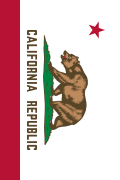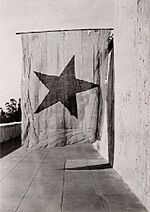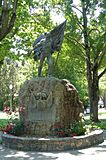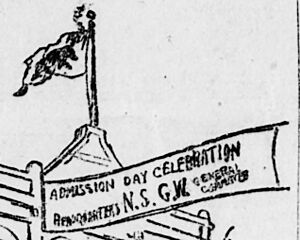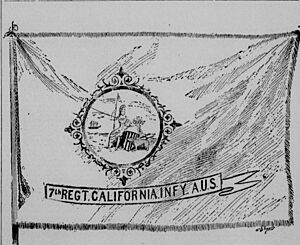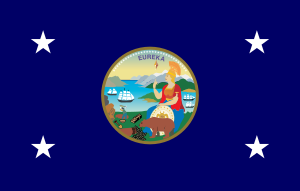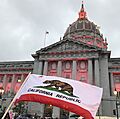Flag of California facts for kids
 |
|
| Name | The Bear Flag |
|---|---|
| Use | Civil and state flag, state ensign |
| Proportion | 2:3 |
| Adopted | February 3, 1911 (original version) June 14, 1953 (standardized version) |
| Design | A single red star in the canton, a red stripe along the bottom, and a California grizzly bear atop a mound of green grass defacing a white field. |
| Designed by | Donald Graeme Kelley, based on flag flown during the Bear Flag Revolt |
The Bear Flag is the official flag of the U.S. state of California. It's a famous symbol of California's history and spirit. The first version of this flag was flown way back in 1846 during an event called the Bear Flag Revolt.
Before that, in 1836, another flag called the Lone Star Flag was used during a movement for independence. The red star you see on today's Bear Flag comes from that earlier flag.
Contents
What Does the California Flag Look Like Today?
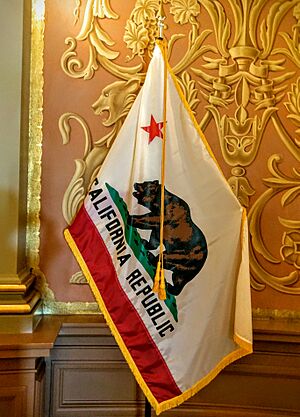
Rules for the Flag
The California flag has specific rules about its design and how it should be displayed. In 1911, a law officially made the Bear Flag the state flag. This law described exactly what the flag should look like.
It said the flag should be one and a half times longer than it is wide. The top five-sixths of the flag is white, and the bottom one-sixth is a red stripe. In the top left corner, there's a single red star. Below the bear, the words 'California Republic' are written. In the middle of the white part, there's a California grizzly bear walking to the left on a patch of green grass. The bear is dark brown and takes up one-third of the flag's length.
In 1953, the flag's design was made even more exact. Governor Earl Warren signed a bill that standardized the flag, meaning its look became official and couldn't be changed by different flag makers. Donald Graeme Kelley helped illustrate this standard design. The law officially calls it the "Bear Flag."
The California Adjutant General is in charge of setting rules for when, where, and how the state flag should be displayed. If the flag is hung vertically (up and down), it's turned 90 degrees clockwise. This way, the bear and star still face upwards, and the red stripe is on the left. The flag is also used on ships as the state ensign.
Flag Design Details
The first official Bear Flag was adopted in 1911 by the California State Legislature. Hiram Johnson, the Governor of California at the time, signed it into law.
Today's state flag is mostly white with a wide red stripe at the bottom. A red star is in the upper left corner. In the center, a grizzly bear walks to the left on a patch of green grass. The bear is about two-thirds the height of the flag. The five-point red star is a nod to the 1836 California Lone Star Flag.
The bear on the 1911 flag was supposedly based on a real California grizzly bear named "Monarch." This bear was captured in 1889 and lived in zoos in San Francisco. After Monarch died in 1911, its body was preserved and displayed at the California Academy of Sciences.
Even after 1911, the bear's image on the flag varied a bit until 1953. That's when Donald Greame Kelley standardized the bear's look, basing it on an 1855 painting by Charles Christian Nahl. The 1953 law includes an official drawing of the bear and grass, along with exact colors and sizes.
The California flag is one of only two U.S. state flags that show a bear. The other is Missouri's flag. In 2001, experts on flags (called vexillologists) ranked California's flag as the 13th best among U.S. states. They also said it was the best flag that includes words.
Flag Colors
The 1953 law also set the exact shades for the California flag's five colors (including white). California's flag is one of only four U.S. state flags that doesn't use the color blue.
| Color | Pantone | Web color | RGB values |
|---|---|---|---|
| White | Safe | #FFFFFF |
(255,255,255) |
| Old Glory Red | 200 | #B71234 |
(183,18,52) |
| Maple Sugar | 729C | #BD8A5E |
(189,138,94) |
| Seal | 462C | #584528 |
(88,69,40) |
| Irish Green | 348 | #008542 |
(0,133,66) |
- Seal is a dark brown used for the bear's shading, some grass tufts, the grass border, and the words "CALIFORNIA REPUBLIC."
- Maple Sugar is a lighter brown, the main color for the bear.
- Old Glory Red is used for the star, the bear's tongue, and the red stripe at the bottom.
- Irish Green is used for the grass patch.
- The bear's claws are highlighted with white.
The Story Behind the Flag
The Lone Star of California
In 1836, a leader named Juan Bautista Alvarado tried to make Alta California independent from Mexico. He called himself governor and got help from American frontiersmen. They easily took over the capital, Monterey. However, they couldn't get leaders from the southern parts of California to join them.
To avoid a civil war, Alvarado and other local leaders made a deal with the Mexican government. California would remain part of Mexico but would have more local control. Alvarado became governor the next year. The flag used during Alvarado's rebellion was called the Lone Star Flag of California. It had a single red star on a white background. One of these original flags is kept at the Autry National Center today.
The Original Bear Flag
The very first grizzly bear flag was made by Peter Storm. Another version of this bear flag, designed by William L. Todd, was raised in Sonoma, California, in June 1846. The men who raised it became known as the "Bear Flaggers."
William L. Todd was a cousin of Mary Todd Lincoln, who was Abraham Lincoln's wife. Todd wrote in a letter in 1878 that he drew the star on the flag using blackberry juice. He said the star was a tribute to the 1836 California Lone Star Flag. The bear was meant to show strength and strong resistance.
The original Bear Flag and the short-lived republic it represented lasted only from about June 14 to July 9, 1846. On July 7, the U.S. Navy claimed California for the United States. Two days later, on July 9, a Navy lieutenant took down the Bear Flag in Sonoma and raised the Stars and Stripes.
The original Bear Flag was later given to the Society of California Pioneers in San Francisco. Sadly, it was destroyed in the fires that followed the great San Francisco earthquake of 1906 on April 18, 1906. Today, a copy of the flag hangs in the Sonoma Barracks. There's also a statue in Sonoma, California, called the Bear Flag Monument, which remembers when the flag was first raised.
Other Early Bear Flags
Many other bear flags were made during the revolt. Each one had a slightly different design. Most had a bear as the main image, either brown or black. Some showed the bear standing, while others showed it on all fours. Most stories about these flags were told many years after the revolt.
One person, George W. Williams, said that within ten days of June 14, 1846, "there were a dozen Bear Flags made and floated." People wanted them for their boats, stores, or public places.
A year after the revolt, American settlers in the Sacramento Valley wanted to celebrate the 4th of July. They didn't have an American flag, so they made one. It was described as a small blue cloth with a white paper star and the words: "California is ours as long as the stars remain."
The 1850s
On September 9, 1850, San Franciscans celebrated California becoming a state. They flew an American flag with one large star representing California. Another flag flown was the first state flag, which had the state seal painted in its center.
From 1850 to 1858, people across the country flew American flags with 31 stars arranged in a "Grand Luminary" pattern. This meant the stars in the corner were arranged to form one big star.
During the 1856 presidential election, supporters of Republican candidate John C. Frémont raised a Bear Flag in San Francisco. Another was raised in Marysville, but it had the names "Fremont and Dayton" on it.
The Civil War Period
During the time leading up to and during the American Civil War in 1861, California was divided. Some people supported the Union, while others supported the Southern states that wanted to leave the Union. In some areas, people showed support for leaving the Union by flying different versions of the Bear Flag instead of the American flag.
One Bear Flag flown in Los Angeles in May was described as a "deep red flag with a black bear painted on it." Other flags were also flown to show support for either side. Unionists (those who supported the United States) raised the Stars and Stripes and other patriotic flags.
In July 1861, during Independence Day celebrations in Sacramento, a man named Maj. J. P. Gillis unfurled a flag similar to the first Confederate flag, but with seventeen stars. A Unionist named Jack Biderman tore the flag from his hands. This flag is now called the "Biderman Flag" or "Gillis Flag" and is kept in the California State Capitol.
In June 1861, the San Francisco Board of Supervisors ordered three flags. One was based on the first state flag, with the California Coat of Arms added to it. A year later, a similar banner was hung in the city, but the seal was surrounded by small American flags.
From the 1870s to the 1910s
Throughout the 1870s, the Bear Flag usually showed a brown bear on a plain white background, without a star or stripe. This flag was used by groups like the Native Sons of the Golden West. Sometimes, it was given as a prize for boat races. In 1885, the Bear Flag was first officially used to represent California at the Southern Exposition.
During the 1888 Democratic National Convention, California delegates carried a large white silk banner with the state seal in the middle and typical California scenes in each corner.
In 1890, during the Admission Day Celebration in San Francisco, three unique flags represented the state. One showed two cowboys lassoing a grizzly bear with Mount Shasta in the background. Another had the Great Seal of California. The third showed the North Star with a grizzly bear in front. Two years later, a Bear Flag similar to the modern state flag was hung in Los Angeles.
On June 14, 1896, Sonoma celebrated the 50th anniversary of the Bear Flag Revolt. The town raised a copy of the original Bear Flag, which is still in the Sonoma Barracks.
During the Spanish–American War, California troops carried two regimental flags. One had the state seal and the regiment's name. The other was an American flag with the regiment's name on its stripes.
In 1909, the USS California was given two flags: a Bear Flag and one with the state seal. Three years later, the last state flag to include the state seal was carried in a women's suffrage parade in New York City. In 1933, for California's 83rd anniversary of becoming a state, a unique Bear Flag was flown. It was a plain red flag with a golden bear in the center.
Flag of the Governor
The flag of the governor of California has the seal of California in the center of a blue background. Like many other U.S. governors' flags, it has four five-point stars in the corners.
Images for kids
-
The Bear Flag Guidon, carried by the California Battalion.
-
Digital reconstruction of the Bear Flag described by Hubert Howe Bancroft.
-
.
Digital reconstruction of the Bear Flag from Alexander Todd's account.
-
Digital reconstruction of the "Lone Star" flag flown in Plumas County on July 4, 1852.
-
Digital reconstruction of the flag carried by Californios in San Francisco during the admission day parade.
-
Digital reconstruction of the state flag flown in the Bay Area in 1864.
-
The flag flying in front of San Francisco City Hall.
See also
 In Spanish: Bandera de California para niños
In Spanish: Bandera de California para niños
- List of California state symbols
- List of flags by design
- List of U.S. state, district, and territorial insignia


